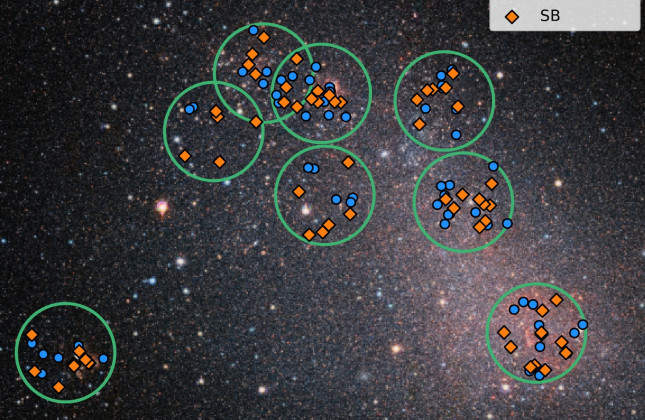For the past twenty years, astronomers have known that many massive stars in the metal-rich Milky Way have a partner. In recent years, it has become clear that the interaction between these partners is important for the evolution of massive stars. However, until now, astronomers were unsure if massive stars in metal-poor galaxies, could also be part of a binary system. Now, it turns out that this is indeed the case.
Time machine
"We used the Small Magellanic Cloud as a time machine," explains Hugues Sana from KU Leuven (Belgium). "The Small Magellanic Cloud has a metallicity environment representative of that of distant galaxies when the Universe was only a few billion years old."
Studying massive stars outside of the Milky Way is difficult because the stars are far away and we receive little light from them. The researchers used the FLAMES spectrograph on the Very Large Telescope of the European Southern Observatory in Chile. It is one of the largest telescopes on Earth. FLAMES has 132 fiber optics, each of which can be directed at a different star, which can then be observed simultaneously.
Accelerate and decelerate
Over a period of 3 months, the researchers observed the acceleration and deceleration of 139 massive O-type stars at 9 different times. These stars have masses between 15 and 60 times that of our Sun. They are hot, shine brightly, and end their lives in supernova explosions. In the process, the star's core collapses into a black hole. De results show that over 70 percent of the observed stars accelerates and decelerates. That is a sign for a nearby partner.
"The fact that massive stars in the Small Magellanic Cloud have a partner suggests that the first stars in the universe, which we suspect were also massive, had partners, too," says co-author Julia Bodensteiner of the University of Amsterdam (the Netherlands). "Perhaps some of those systems end up as two black holes orbiting each other. It’s an exciting thought."
The researchers have planned to observe the same stars sixteen more times in the near future. They aim to reconstruct the precise orbits of the binary stars, determine the masses of their components, and study the nature and properties of the companion star.
"Using our measurements, cosmologists and astrophysicists studying the young, metal-poor universe will then be able to rely on our knowledge of massive binary stars with greater confidence," concludes the Tomer Shenar of Tel Aviv University (Israel).
Scientific paper
A high fraction of close massive binary stars at low metallicity. By: Hugues Sana, Tomer Shenar, Julia Bodensteiner, et al. In: Nature Astronomy, 2 September 2025. [original | preprint (pdf)]
 Massive stars in the Small Magellanic Cloud. Of the stars studied, seventy percent (the red diamonds) appear to accelerate and decelerate. This indicates the presence of a partner. (c) ESO/Sana et al. [hoge resolutie]
Massive stars in the Small Magellanic Cloud. Of the stars studied, seventy percent (the red diamonds) appear to accelerate and decelerate. This indicates the presence of a partner. (c) ESO/Sana et al. [hoge resolutie]
